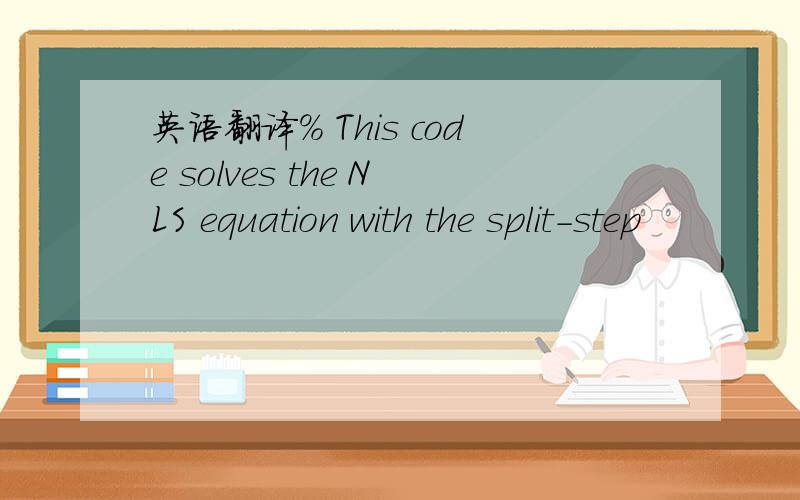英语翻译% This code solves the NLS equation with the split-step
来源:学生作业帮 编辑:大师作文网作业帮 分类:综合作业 时间:2024/11/13 20:13:14
英语翻译
% This code solves the NLS equation with the split-step method
% idu/dz - sgn(beta2)/2 d^2u/d(tau)^2 + N^2*|u|^2*u = 0
% Specify input parameters
clear all;
distance=10; % fiber length
beta2 = -1; % dispersion of fober
N = 1; % nonlinear parameter
mshape = 1; % pulse shape mshap=0 for sech,mshape>0 for super-Gausssian
chirp0 = 0; % input pulse chirp (default value)
%%%%%%%%%%% set simulation parameters
nt = 1024; Tmax = 32; % FFT points and window size
step_num = round(20*distance*N^2); % No.of z steps to
deltaz = distance/step_num; % step size in z
dtau = (2*Tmax)/nt; % step size in tau
%%%%%%%%% tau and omega arrays
tau = (-nt/2:nt/2-1)*dtau; % temporal grid
omega = (pi/Tmax)*[(0:nt/2-1) (-nt/2:-1)]; % frequency grid
%%%%%%%%% Input Field profile
if mshape==0
uu = sech(tau).*exp(-0.5i*chirp0*tau.^2); % soliton
else % super-Gaussian
uu = exp(-0.5*(1+i*chirp0).*tau.^(2*mshape));
end
%%%%%%%%% Plot input pulse shape and spectrum
temp = fftshift(ifft(uu)).*(nt*dtau)/sqrt(2*pi); % spectrum
figure(1);
subplot(2,1,1);
plot(tau,abs(uu).^2,'r','linewidth',2); hold on;
axis([-5 5 0 inf]);
xlabel('Normalized Time');
ylabel('Normalized Power');
subplot(2,1,2);
plot(fftshift(omega)/(2*pi),abs(temp).^2,'b','linewidth',2);
hold on;
axis([-.5 .5 0 inf]);
xlabel('Normalized Frequency');
ylabel('Spectral Power');
%%%%%%%%% store dispersive phase shifts to speedup code
dispersion = exp(i*0.5*beta2*omega.^2*deltaz); % phase factor
hhz = i*N^2*deltaz; % nonlinear phase factor
%%%%%%%% [ Beginning of MAIN Loop] %%%%%%%%%%%
%%%%%%%% scheme:1/2N -> D -> 1/2N; first half step nonlinear
temp = uu.*exp(abs(uu).^2.*hhz/2); % note hhz/2
for n=1:step_num
f_temp = ifft(temp).*dispersion;
uu = fft(f_temp);
temp = uu.*exp(abs(uu).^2.*hhz);
end
uu = temp.*exp(-abs(uu).^2.*hhz/2); % Final field
temp = fftshift(ifft(uu)).*(nt*dtau)/sqrt(2*pi); %Final spectrum
%%%%%%%% [ End of MAIN Loop ] %%%%%%%%%%%%%
%%%%%%%% Plot output pulse shape and spectrum
figure(2);
subplot(2,1,1);
plot(tau,abs(uu).^2 ,'c','linewidth',2);
hold on;
axis([-5 5 0 inf]);
xlabel('Normalized Time');
ylabel('Normalized Power');
subplot(2,1,2);
plot(fftshift(omega)/(2*pi),abs(temp).^2,'k','linewidth',2);
hold on;
axis([-.5 .5 0 inf]);
xlabel('Normalized Frequency');
ylabel('Spectral Power');
% This code solves the NLS equation with the split-step method
% idu/dz - sgn(beta2)/2 d^2u/d(tau)^2 + N^2*|u|^2*u = 0
% Specify input parameters
clear all;
distance=10; % fiber length
beta2 = -1; % dispersion of fober
N = 1; % nonlinear parameter
mshape = 1; % pulse shape mshap=0 for sech,mshape>0 for super-Gausssian
chirp0 = 0; % input pulse chirp (default value)
%%%%%%%%%%% set simulation parameters
nt = 1024; Tmax = 32; % FFT points and window size
step_num = round(20*distance*N^2); % No.of z steps to
deltaz = distance/step_num; % step size in z
dtau = (2*Tmax)/nt; % step size in tau
%%%%%%%%% tau and omega arrays
tau = (-nt/2:nt/2-1)*dtau; % temporal grid
omega = (pi/Tmax)*[(0:nt/2-1) (-nt/2:-1)]; % frequency grid
%%%%%%%%% Input Field profile
if mshape==0
uu = sech(tau).*exp(-0.5i*chirp0*tau.^2); % soliton
else % super-Gaussian
uu = exp(-0.5*(1+i*chirp0).*tau.^(2*mshape));
end
%%%%%%%%% Plot input pulse shape and spectrum
temp = fftshift(ifft(uu)).*(nt*dtau)/sqrt(2*pi); % spectrum
figure(1);
subplot(2,1,1);
plot(tau,abs(uu).^2,'r','linewidth',2); hold on;
axis([-5 5 0 inf]);
xlabel('Normalized Time');
ylabel('Normalized Power');
subplot(2,1,2);
plot(fftshift(omega)/(2*pi),abs(temp).^2,'b','linewidth',2);
hold on;
axis([-.5 .5 0 inf]);
xlabel('Normalized Frequency');
ylabel('Spectral Power');
%%%%%%%%% store dispersive phase shifts to speedup code
dispersion = exp(i*0.5*beta2*omega.^2*deltaz); % phase factor
hhz = i*N^2*deltaz; % nonlinear phase factor
%%%%%%%% [ Beginning of MAIN Loop] %%%%%%%%%%%
%%%%%%%% scheme:1/2N -> D -> 1/2N; first half step nonlinear
temp = uu.*exp(abs(uu).^2.*hhz/2); % note hhz/2
for n=1:step_num
f_temp = ifft(temp).*dispersion;
uu = fft(f_temp);
temp = uu.*exp(abs(uu).^2.*hhz);
end
uu = temp.*exp(-abs(uu).^2.*hhz/2); % Final field
temp = fftshift(ifft(uu)).*(nt*dtau)/sqrt(2*pi); %Final spectrum
%%%%%%%% [ End of MAIN Loop ] %%%%%%%%%%%%%
%%%%%%%% Plot output pulse shape and spectrum
figure(2);
subplot(2,1,1);
plot(tau,abs(uu).^2 ,'c','linewidth',2);
hold on;
axis([-5 5 0 inf]);
xlabel('Normalized Time');
ylabel('Normalized Power');
subplot(2,1,2);
plot(fftshift(omega)/(2*pi),abs(temp).^2,'k','linewidth',2);
hold on;
axis([-.5 .5 0 inf]);
xlabel('Normalized Frequency');
ylabel('Spectral Power');

我是光学工程硕士研究生,希望我能给你帮助.
学习光信息,要学好高等数学、概率论与数理统计、线性代数、复变函数,这是数学基础,包括积分微分统计等等.
光学基础包括电动力学,数学物理方法,量子力学,这是光学的基础.包括麦克斯韦方程,这是基础.
光学专业知识包括:光学、信息光学、导波光学、红外光学、激光原理、光电子.
另外光电不分家的,电学也要学习,包括电路基础、模拟电路、数字电路等.
软件方面有MATLAB、zmax、beamprop等.
还有什么问题可以直接问我.
加油↖(^ω^)↗
学习光信息,要学好高等数学、概率论与数理统计、线性代数、复变函数,这是数学基础,包括积分微分统计等等.
光学基础包括电动力学,数学物理方法,量子力学,这是光学的基础.包括麦克斯韦方程,这是基础.
光学专业知识包括:光学、信息光学、导波光学、红外光学、激光原理、光电子.
另外光电不分家的,电学也要学习,包括电路基础、模拟电路、数字电路等.
软件方面有MATLAB、zmax、beamprop等.
还有什么问题可以直接问我.
加油↖(^ω^)↗
英语翻译the parameter of B,this equation is esimated with weight
英语翻译This paper solves the range close-pair query using two c
英语翻译“put this equation in the form of logistic function"
英语翻译the first step in successful communication with the oppo
英语翻译Getting Started With the Code Composer Studio TutorialTh
英语翻译Problem has occurred with the hack shield function.(Code
英语翻译1.In the xy-plane,the line with equation y=5x-10 crosses
英语翻译step the
英语翻译This is the first step in achieving cultural capability
英语翻译living in accordance with the Code of Ethics is the happ
The roots of a quadratic equation with rational coefficients
solve the equation .